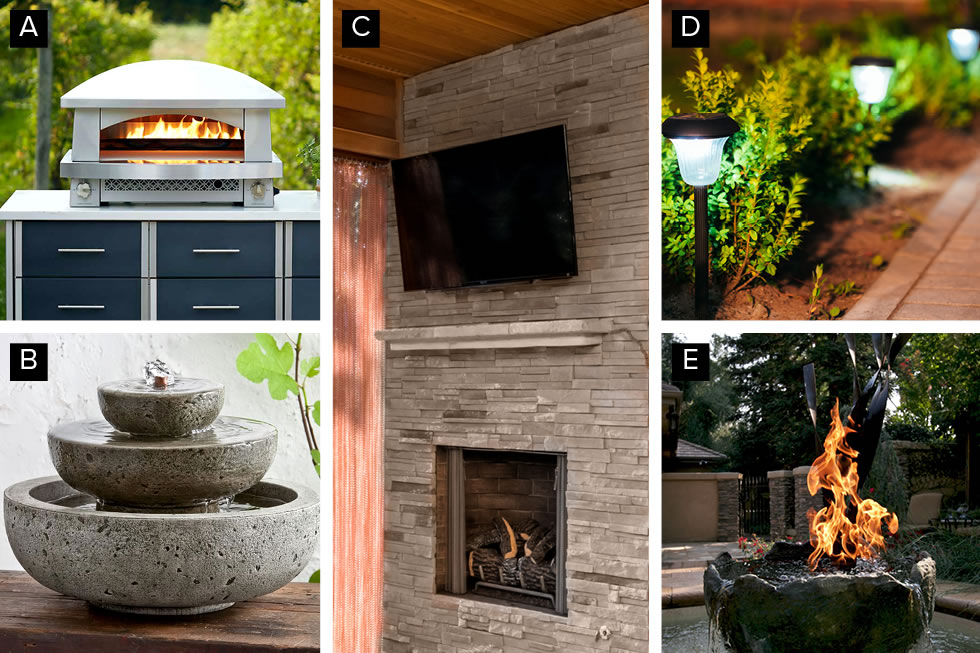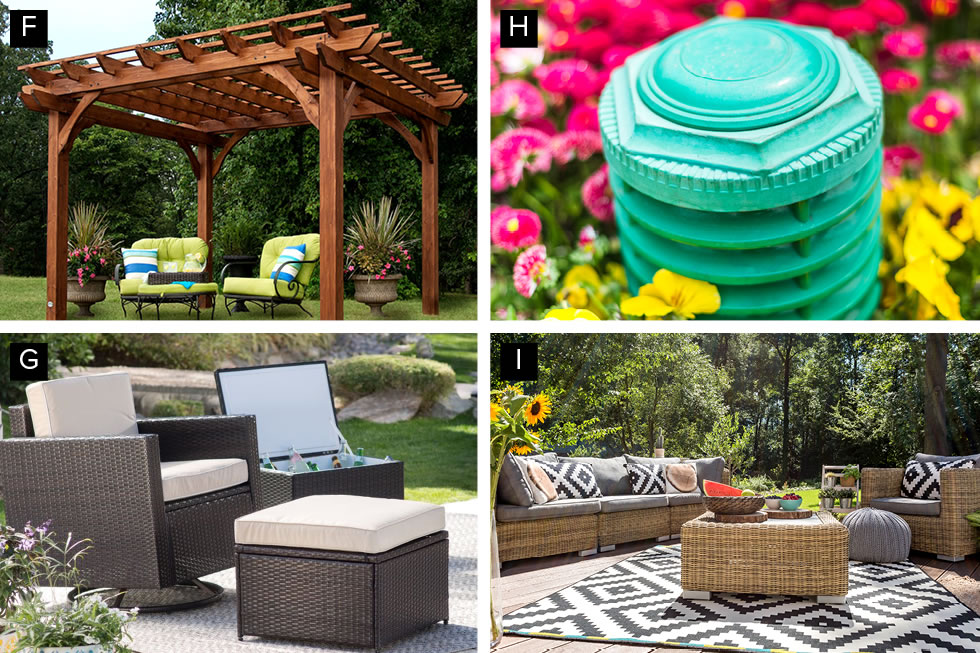
As outdoor living has become a priority for more home owners, many find that in addition to landscaping, they crave some of the creature comforts enjoyed indoors. Today, there are a variety of unique additions to ratchet up your enjoyment of outdoor areas at your home place.
Following are eight product or concept options you may consider, whether your outdoor area is a terrace, deck, patio, lawn panel or small balcony in an urban locale. To find the best options for your area, it’s a good idea to consult with a local landscape designer. Our "tour guide" for these eight essentials is garden designer Michael Glassman of Michael Glassman & Associates, based in Sacramento, CA. He’s currently in the process of incorporating some of these concepts into his own new outdoor area.
Rugs. Once the domain only of interiors, they now are made in materials such as polypropylene, jute and coir that can withstand outdoor activities and be hosed down. Many also won’t fade in sunlight. Glassman prefers choices that are lightweight so they can be moved, though some manufacturers say they can be left out all year even in inclement weather. He likes to use them under a coffee table or as a runner on a deck, but they can also be placed atop a lawn or hardscape surface by a fire pit. Their prime benefit is to create the feeling of an indoor room. Find them in home furnishings and big box stores and online through resources such as One Kings Lane.
Lighting. With low-voltage LED options now available for outdoor areas, any space can be illuminated, from a walkway to a terrace to shrubs, trees and fountains. Glassman also likes the light they give off, which, he finds, is softer and more on the yellow side than many of the solar-powered blue choices. "They’re easier on the eye," he says. Best of all, you can install them yourself without an electrical permit. "Just dig a trench for the cable, pile dirt on top and you’ve got illumination—and for a very long time," he says. Many come as part of a kit with fixtures, transformer, bulbs, wire and more. Prices vary greatly, depending on where they’re purchased and if part of a kit or single light. Glassman’s caveat is to avoid using too many together – no need to create the look of an airport runway. "Consider them more of an accent and vary the amount of light according to the function. You’ll want more light to see the food you eat versus highlighting a fountain," he says.
Sound. Due to the availability of wireless technology, you can bring music, podcasts, sports or news shows into your outdoor living space. Numerous manufacturers such as Bose offer good options, which you can also connect to a smart device. "Alexa, please play the sound track for Hamilton," you might say, for example. Some devices resemble garden motifs such as speakers that look like rocks, which manufacturer Klipsch offers for about $300.
Outdoor TVs and movie screens. For those who can’t do without their favorite movies, TV shows or other programs, there are weatherproof, non-glare outdoor TVs available as well as retractable large screens. One manufacturer SunBriteTV offers TV choices for partial and full sun as well as shade. Focused Technology has packages with a projector, large screen, speakers, Blu-Ray player and AV cables. Even though these items are weatherproof, it’s still best to mount in an area that’s covered overhead.
Kitchens. Although still popular, many home owners are downsizing their outdoor kitchens for cost, maintenance and practicality, even when they have large outside areas. Many are realizing that they don’t use all the bells and whistles they thought they might and have found how easy it is just to step inside for certain tasks. Instead of a freestanding pizza oven, they might opt for a countertop model or a great pizza stone, for example. Glassman and his wife Elaine took that approach when they recently designed their new outdoor kitchen. They only added a good barbecue pit with plenty of countertop space to work on and ample storage. "Most of the outdoor refrigerators aren’t very energy efficient," he says. The big decisions then are what type of barbecue—gas, charcoal or a hybrid of some kind, as well as the length and specifics of the warranty. Kalamazoo, known for its high-end products, now makes a model to cook with charcoal, gas and wood! Also, pick a model with the number of burners you’re likely to use, he says. "I’ve never used the fifth one on my old model," he says. He also likes a quality stainless steel, granite or concrete top. Prices depend on quality and options.

Fire pits. Many are portable, which is an advantage unless you have a specific spot where you plan to leave it permanently. Consider one that’s at least 3 by 4 feet and made of iron, metal or cement. You have the choice of running a natural gas line if it’s stationary or using a small propane tank for portability. Some work by using fire crystals, glass beads or rocks. And then, there’s always the old-fashioned way of using logs and lighting a fire. You can spend as little as a few hundred dollars all the way up to a few thousand, and in most cases they’re far less costly than constructing a fireplace. Before a purchase, always check with your municipality regarding setbacks from a house and if a permit is needed.
Water. Features that offer the sound of trickling water—and the sight—are now available in smaller sizes than a big gushing waterfall in a pool or stream. Consider a bird bath with a pump, which you plug in, so the water recirculates and doesn’t get dirty and isn’t as likely to attract mosquitoes. Costs vary, from under one hundred dollars to more than one thousand and upwards, but still far less than a custom designed pond, which also requires more maintenance.
Pergolas. For years, the idea of having a structure that replicates something seen on a vacation in Italy or California has gained ground, and many home owners like to grow vines atop them or flowers along the sides. They also can offer shade with a fabric or metal cover. While you can have one custom crafted to your site, exact size and material preferred, there are also models for do-it-yourselfers available in big-box stores. Some caveats from Glassman: If choosing wood, go with a choice that will weather naturally such as redwood, cedar or pressure treated wood that won’t need frequent repainting, or consider a vinyl that won’t require much upkeep; choose a design at least 10 feet by 10 feet so it’s comfortable to sit or dine under; be sure the design is sturdy, and once installed add the vines or flowers to soften the look and create pleasant smells. Good choices are grapevines, trumpet flowers, star jasmine and climbing roses.
Seating. Since you’re likely to spend time savoring your view or newly added features, pick comfortable seating that will last—that’s deep enough, easy to get into and out of and includes good quality cushions. You also want choices that will weather well. Teak is practical and attractive but can be pricey; less expensive can be a faux rattan that wears well and aluminum that resembles wood. If you like the Adirondack-style look consider polywood, which weathers well when left outdoors. Wrought iron gives old-world charm but can be heavy to move if you want to store it indoors.
Photo Credits:
A: Michael Glassman & Associates and kalamazoogourmet.com, B: PotteryBarn.com and Michael Glassman & Associates, C: Getty Images, D: Getty Images, E: Michael Glassman and Associates., F: Samsclub.com, G: Michael Glassman & Associates and hayneedle.com, H: Getty Images, I: Getty Images
